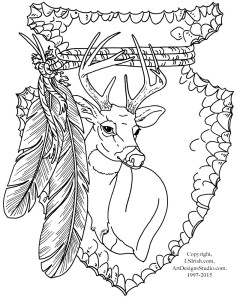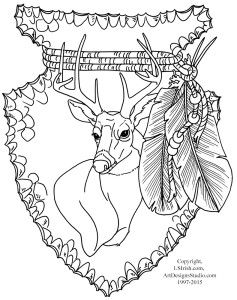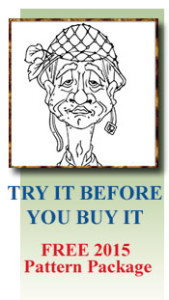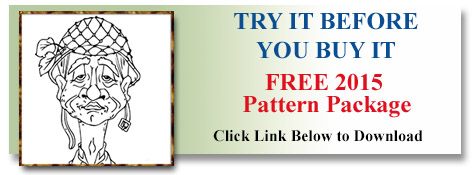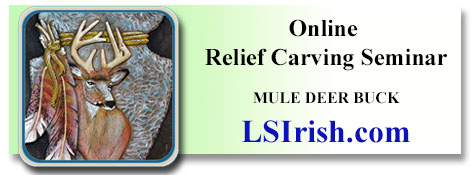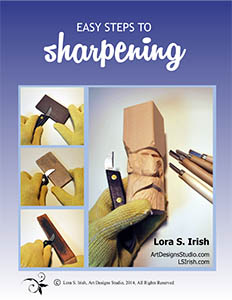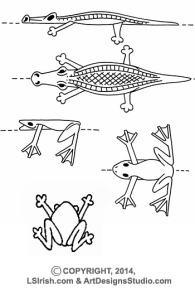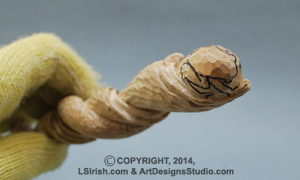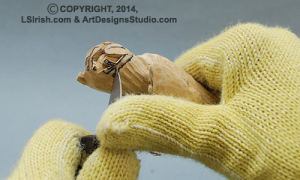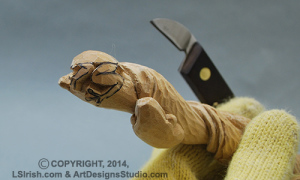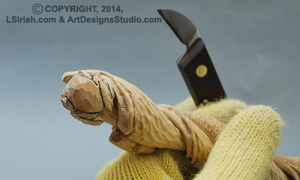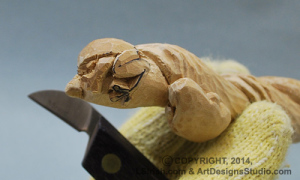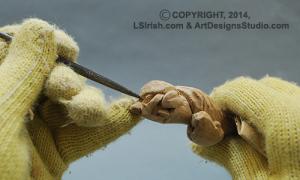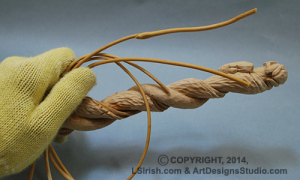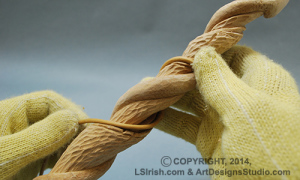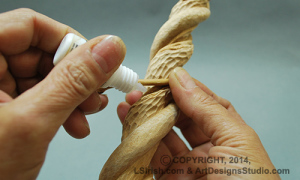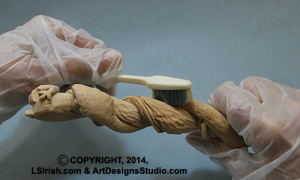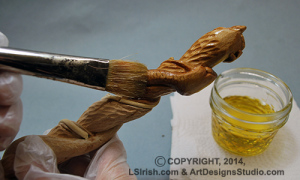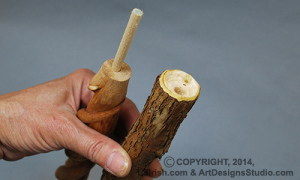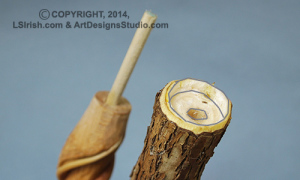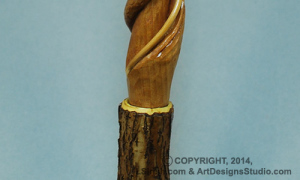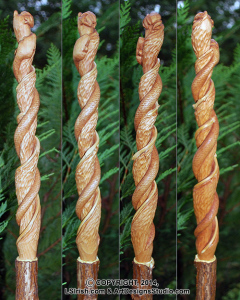Stop Cuts and Rough Out Steps in Relief Wood Carving
The stop cut is a two-stroke bench knife cut that frees a v-shaped trough along a pattern line. A round, flat, or bull nose chisel is then used to cut the wood in the lower level of the design, sliding the chisel into the stop cut. When the chisel edge meets the stop cut a clean sliver of wood is released without damaging the higher level. Today we are going to look at the steps used to create a stop cut and to do basic rough out work in your relief wood carvings.
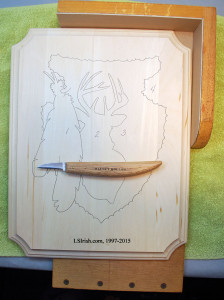 Begin by tracing your pattern to the wood blank. Because you will be cutting away background wood and dropping areas of the pattern into different levels or depths in the blank you need only trace the outlines of each area. All detail tracing will be lost during the rough out stage.
Begin by tracing your pattern to the wood blank. Because you will be cutting away background wood and dropping areas of the pattern into different levels or depths in the blank you need only trace the outlines of each area. All detail tracing will be lost during the rough out stage.
The pattern shown here, the Mule Deer Buck, is an in-depth tutorial that is posted at FamilyWoodworking.org and WoodworkingChat.com. These are two great, online message boards where wood carvers and woodworkers can share their ideas, experiences, and techniques.
Stop Cut
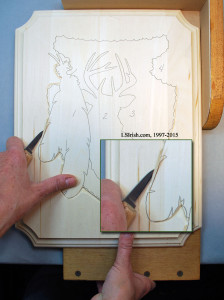 1. The stop cut is a two-step stroke. Begin by laying your bench knife vertically along the outside edge of your pattern line. Pull a shallow cut following the pattern line.
1. The stop cut is a two-step stroke. Begin by laying your bench knife vertically along the outside edge of your pattern line. Pull a shallow cut following the pattern line.
2. Move the tip of your bench knife a small amount of space away from your first cut. Angle the knife tip towards the first cut. Pull a shallow cut, maintaining that small space between the knife tip and the first cut.
3. The two cuts will release a thin, shallow v-shaped chip of wood. The chip will leave a straight wall along the pattern line and an angled wall in the background area of the pattern.
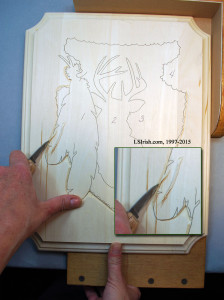 4. You can deepen a stop cut by re-cutting, using the same steps, several times. This ‘walks’ the v-shaped trough deeper into the wood.
4. You can deepen a stop cut by re-cutting, using the same steps, several times. This ‘walks’ the v-shaped trough deeper into the wood.
5. Stop cuts may also be created using a v-gouge. The v-gouge makes both the straight wall cut and the slanted side cut in one stroke. The g-gouge works exceptionally well when you are creating stop cuts that flow with the grain of the wood. For tight areas in a pattern, as the small openings in the feathers in the pattern shown, you may find that the bench knife will provide more control.
Rough Cutting into a Stop Cut
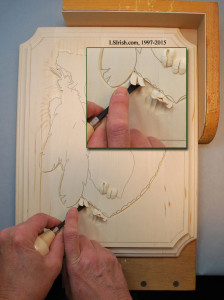 1. You can use a round gouge, straight chisel, or bull nose chisel to rough cut a background area that has been stop cut at the pattern line. I prefer a large, wide-sweep round gouge for my first rough-out cuts. The wide-sweep takes a shallow but wide chip of wood with each cut. That allows me to slowly drop the depth of an area while taking a large chip of wood with each cut.
1. You can use a round gouge, straight chisel, or bull nose chisel to rough cut a background area that has been stop cut at the pattern line. I prefer a large, wide-sweep round gouge for my first rough-out cuts. The wide-sweep takes a shallow but wide chip of wood with each cut. That allows me to slowly drop the depth of an area while taking a large chip of wood with each cut.
2. Start you cut about 3/8″ to 3/4″ from the stop cut in the background area. Move the chisel or gouge edge towards the stop cut, slowly deepening the cut as you work. Stop when your gouge reaches the stop cut. I usually cut a series of gouge cuts, that slightly overlap.
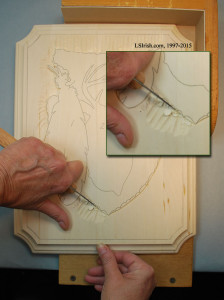 3. Make a shallow, vertical cut, using your bench knife along the pattern line to release any gouge chips that are still connected to the wood.
3. Make a shallow, vertical cut, using your bench knife along the pattern line to release any gouge chips that are still connected to the wood.
4. Alternate your stop cuts with your gouge rough-out cuts to slowly drop the background area to your desired depth in the wood.
5. The background area that has been gouge rough cut will at this stage will slowly taper from the original level of the wood at its most distant point in the cut from the pattern line to the your desired depth at the stop cut. Later in any relief carving you can work the remaining background areas down to the same depth.
Practice Board Exercise
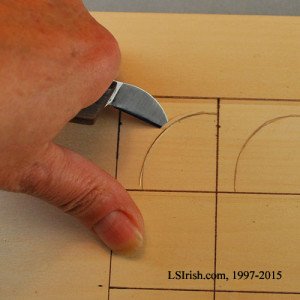 1. Practice boards allow you to try, learn, and experiment with new cuts before you use them in your latest projects. In this sample the reverse side on an older basswood plaque was used as my practice board. I marked the board into 1 1/2″ squares, creating small spaces to experiment with different relief carving cuts. For the stop cut and rough out practice I used a medicine jar cap to draw a half-circle as my pattern line. Begin your practice square by making the two-stroke stop cut using a bench knife or a large chip carving knife.
1. Practice boards allow you to try, learn, and experiment with new cuts before you use them in your latest projects. In this sample the reverse side on an older basswood plaque was used as my practice board. I marked the board into 1 1/2″ squares, creating small spaces to experiment with different relief carving cuts. For the stop cut and rough out practice I used a medicine jar cap to draw a half-circle as my pattern line. Begin your practice square by making the two-stroke stop cut using a bench knife or a large chip carving knife.
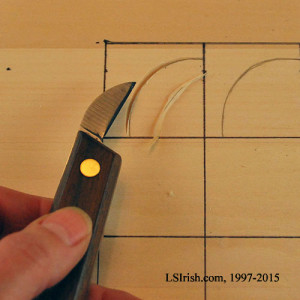 3. You can see in the sample photo how this two-stroke cut releases a long v-shaped wood chip.
3. You can see in the sample photo how this two-stroke cut releases a long v-shaped wood chip.
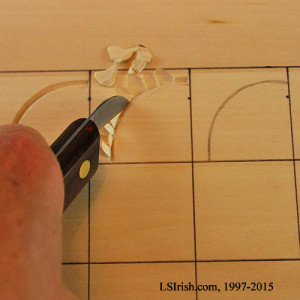 4. Use your round gouge, straight chisel, or bull nose chisel to begin removing the wood in the background area of the design, working from the outer edges of the wood blank into the stop cut line. With your bench knife cut along the stop cut, holding the knife in a vertical position, to free any rough cut chips.
4. Use your round gouge, straight chisel, or bull nose chisel to begin removing the wood in the background area of the design, working from the outer edges of the wood blank into the stop cut line. With your bench knife cut along the stop cut, holding the knife in a vertical position, to free any rough cut chips.
Alternate making stop cuts and working rough out cuts to slowly drop the depth of the background elements in the design.
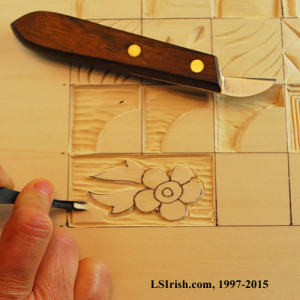 5. Here is the stop cut and rough out cuts used in a small practice pattern.
5. Here is the stop cut and rough out cuts used in a small practice pattern.
Stop Cuts and Rough Out Steps in Relief Wood Carving Read More »
